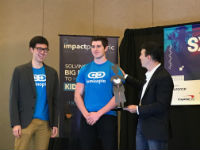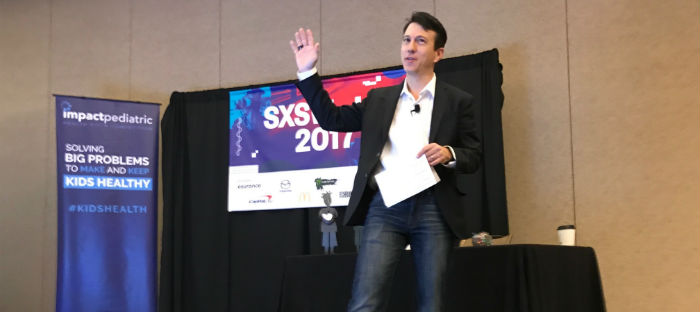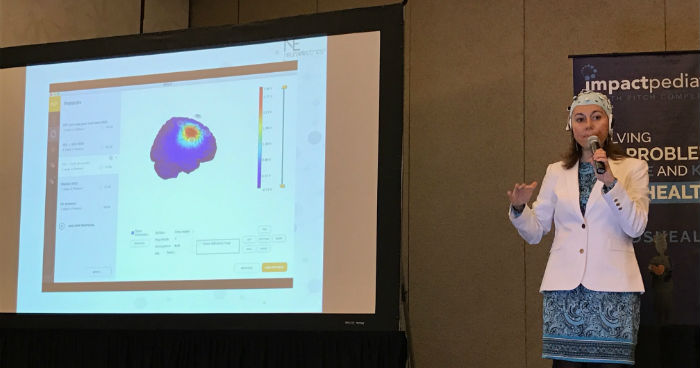
SXSW 2017: Delivering new possibilities to health and care
Every March, the South by Southwest Conference and Festivals (SXSW) fill my home city of Austin, Texas, with big ideas, big names, and big crowds. It’s a different sort of “March Madness” — the type that features smart people and talented performers from the creative, film, music, and technology sectors sharing their wisdom and unvarnished truths on an overwhelming array of topics in predominantly conversational formats. It pushes anyone’s FOMO meter into the red zone!

Luminopia wins in medtech for the Impact Pediatric Health Pitch Competition.
SXSW’s growth over 30 years has been organic, driven by listening for emerging trends and opportunities and acted upon by the comfortable-with-experimentation conference directors. Three years ago, interactive director Hugh Forrest added a designated health track and began inviting a new group of thought leaders, topics, and exhibits to the mix. It’s been exciting having tech-savvy clinicians and the promising startups and upstarts add their voices to this international tech/film/music showcase and having new perspectives contributing to conversations about health, what’s possible, and why we should (or shouldn’t) consider the promises of technology.
AI. Machine Learning. VR. The tech stars of SXSW 2017
With so much new information about “technologies of the intellect” and predictions for our intelligent future it was helpful hearing experts like Microsoft fellow Eric Horvitz share how these technologies will serve, support, and improve human intelligence and endeavors, not replace them. This was certainly evidenced by many of the startups pitching at the SXSW Accelerator and Impact Pediatric Health competitions. iSonoHealth is democratizing breast screening using a wearable that couples 3D ultrasound technology with a machine learning algorithm to track breast tissue changes. Luminopia is replacing the antiquated (and socially stigmatizing) eye patch treatment for amblyopia with VR that launches a new frontier in neurovisual care. emojihealth is activating teens to manage their health using chatbot technology.

Emcee Daniel Kraft, MD kicks off the Pediatric Start-up Pitch at SXSW.
Each of these ventures emphasized the importance of human clinician involvement, citing nursing, and how applying the technology will bring people together. The Nurse Included mindset for developing and evaluating tech-based solutions was evident on the pitch stage and judging panel. Astarte Medical, led by nurse scientist Katherine Gregory, is developing technology platforms to address the needs of high risk pregnancies and preterm births. Molly McCarthy, Microsoft’s Chief Nursing Strategist and Kris Rogers, RN CRA offered insightful clinical, business, technical, social and emotional considerations in judging the ventures. Billionaire and star investor of ABC’s “Shark Tank,” Mark Cuban amped the enthusiasm for AI focused ventures when he predicted the world’s first trillionaires are “going to come from somebody who masters AI and all its derivatives and applies it in ways we never thought of.” That could be an entrepreneur.
Humans and Design. At the center of our thinking.
The concept and practice of human-centered design was widely discussed and featured in significant ways. Design thinking for the dyslexic, for devices that serve a wide range of users, for addressing unmet and orphan needs, and for building more intelligent chatbot conversation that improves navigating care decisions and management were eye-openers. Design Institute for Health founders Stacey Chang and Beto Lopez described how design is increasingly shaping our technology, services, and workflows into experiences that create health, not just care. Their article, published in the New England Journal of Medicine, serves to establish the broader manifesto for design in health and healthcare. An important theme that resonates with nurses is designing for cultural sensitivity and inclusion. From designing to prevent exclusion of differently-abled, disabled and vulnerable populations, to acknowledging unconscious bias that exists among us, and understanding design’s role in ensuring equity, preventing marginalization, and building empathy. Nurses are well positioned to lead in these initiatives and activities.

Ana Maiques, CEO, Neuroelectrics, demonstrates a new innovation to aid epilepsy diagnosis and treatment.
SXSW is a breathtaking convergence of interests and expertise. It’s when the pain points and solutions from adjacent industries are shared that the thought experiments and unexpected collaborations are launched. The film industry teaches us to be better storytellers and historians, the musicians build our sensitivity and emotional intelligence, the gamers identify how to motivate and reward behavior, the fashionistas turn a medical device into a fashion statement, and the celebrities bring glamorous attention to it all. Because there is so much on offer, no two people will have the same SXSW experience or gain the same insights. So please join me for SXSW 2018 and bring your colleagues on the front lines of care — I have a few gamers, rockers, and designers I’d like y’all to meet.




